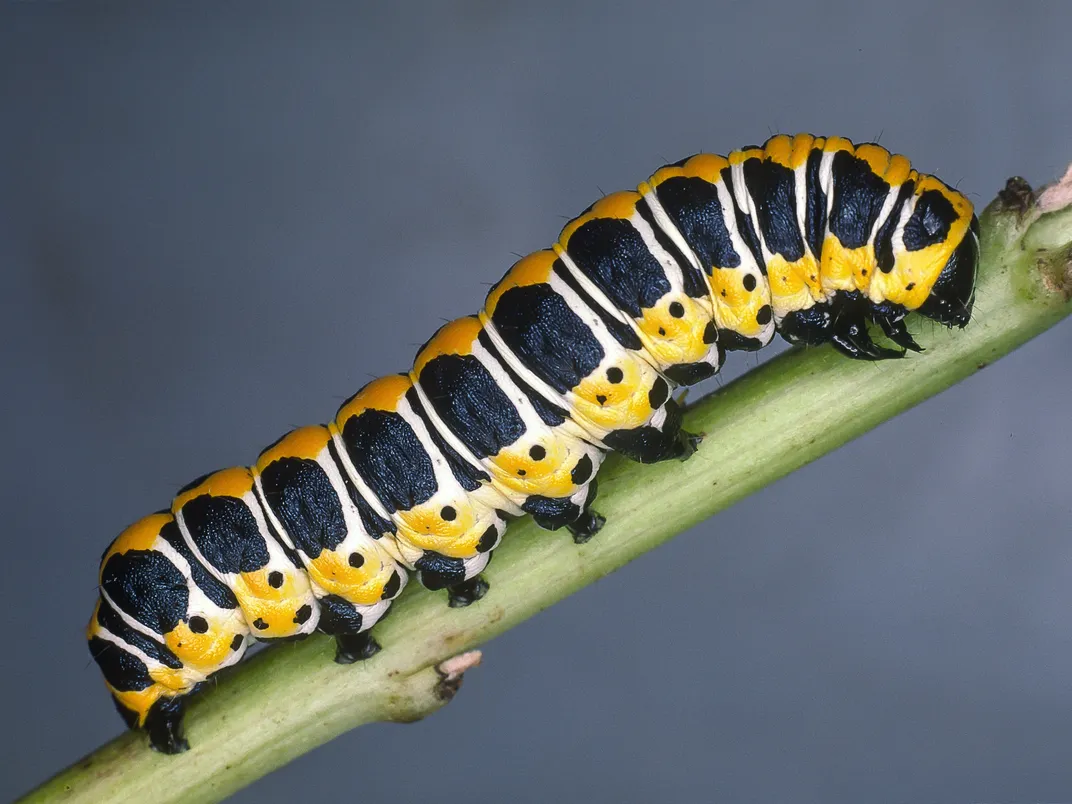Caterpillars Beware: Venom Won’t Protect You From Clueless Baby Birds
Young birds will dumbly peck at anything that crawls their way—even if it winds up teaching them a painful lesson
/https://tf-cmsv2-smithsonianmag-media.s3.amazonaws.com/filer/9b/d5/9bd5fdb4-77a8-465e-b56e-c714c285c887/buckmoth.jpg)
Each April, a plague of buck moth caterpillars descends on New Orleans. They crawl across park benches, up walls and down sidewalks. When the wind blows hard enough, they rain down from oak trees. With tufts of bright red or yellow fuzz, the larvae at first appear adorable—that is, until you make the mistake of touching them. That bright fluff is actually venomous spines, which can leave you with burn-like blisters.
Many caterpillars like the buck moth have evolved a combination of venom and bright colors to warn potential predators: if you can see me, you don’t want to eat me. Other larvae go for the opposite tack, shrouding themselves in camouflage and skipping the toxic sting. So why do some species prefer one defense over the other?
The answer may be clueless baby birds. According to research published today in Nature Communications, fledglings that have just left the nest don’t yet know which colors advertise harmful prey. That avian naivety might have driven caterpillar evolution, pushing larvae that emerge during prime baby bird season to opt for camouflage rather than investing in toxins.
Finnish and Australian researchers arrived at this conclusion after performing some peculiar experiments. They planted more than 1,200 fake larvae around Central Finland that had three color schemes—black, black with a little color or black with a bright orange dot. The fake larvae’s coloration represented some naturally occurring caterpillars of the region. The team placed sets of each larvae type on stems, leaves and branches, essentially giving any bird that came across them a choice between the three colors.
Each of the larvae was attached to a wire, so the team could tell which ones had been pecked at and moved. Bird beaks also tended to leave marks. Then they monitored what happened to their larvae from May to August, to encompass the local birds’ nesting season plus a bit of buffer time before and after.

The would-be larvae’s survival, the team found, very much depended on the birds’ maturity. At first more of the black larvae were chosen, in the weeks when wise mom and pop birds were foraging for their babies’ food. But after fledgling birds left their nests, a disproportionate number of the ultra-conspicuous and semi-conspicuous fake larvae were dislodged from their stems or found maimed.
The authors also sampled 688 real butterfly and moth larvae in the area over the same study period. Conspicuous caterpillars, they found, were exceedingly rare, making up less than 5 percent of all larvae. But those that had evolved to go bold emerged either before fledglings had left the nest or after they had grown into more savvy adults. Intermediate larvae types—those that had a few tentative bright spots but didn’t quite go full-throttle Jackson Pollock—bridged those two periods, so that overall, larvae emerged on a gradient of bright to drab to bright.
The team suspects that young birds will dumbly peck at anything that crawls their way—even if it winds up teaching them a painful lesson. The birds, however, usually get the last laugh. While a beak-full of spines is never fun, for the caterpillars, being pecked at probably spells game over. These findings, the authors write, “uncover an intriguing possibility of a multi-species evolutionary game,” where “later-occurring species essentially exploit the education effort by earlier species.”
/https://tf-cmsv2-smithsonianmag-media.s3.amazonaws.com/accounts/headshot/Rachel-Nuwer-240.jpg)
/https://tf-cmsv2-smithsonianmag-media.s3.amazonaws.com/accounts/headshot/Rachel-Nuwer-240.jpg)